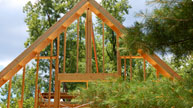Environmental Footprint
 Wood has many attributes that make it an obvious choice for green building. It grows naturally, using energy from the sun, and is the only major building material that’s renewable and sustainable over the long term. It also outperforms steel and concrete when compared using life cycle assessment (LCA) methodology. LCA is an internationally recognized approach to evaluating materials, assemblies and even whole structures, over the course of their entire lives, based on measurable indicators of environmental impact. Using this method, study after study has shown that wood is better for the environment than steel or concrete in terms of:
Wood has many attributes that make it an obvious choice for green building. It grows naturally, using energy from the sun, and is the only major building material that’s renewable and sustainable over the long term. It also outperforms steel and concrete when compared using life cycle assessment (LCA) methodology. LCA is an internationally recognized approach to evaluating materials, assemblies and even whole structures, over the course of their entire lives, based on measurable indicators of environmental impact. Using this method, study after study has shown that wood is better for the environment than steel or concrete in terms of:
- Global warming potential
- Resource use
- Embodied energy
- Air pollution
- Water pollution
Wood also contributes to a building’s energy efficiency and has an important role to play in the fight against climate change. While humans contribute carbon dioxide (CO2) to the atmosphere by burning fossil fuels, growing trees absorb CO2 and release clean oxygen. Some of the CO2 is absorbed into the soil and the rest is stored in trees—and wood products made from trees—until they burn or biodegrade.
Tackle Climate Change book ![]() 7.25MB
7.25MB
LCA on Renewable Industry Materials
Study after study has shown that wood outperforms other materials when considered over its lifetime using LCA. One study, conducted by the Consortium for Research on Renewable Industrial Materials (CORRIM), compared the environmental impacts of homes framed with wood and steel in Minneapolis and homes framed with wood and concrete in Atlanta—the framing types most common to each city.
See how wood compares with other materials and more study results